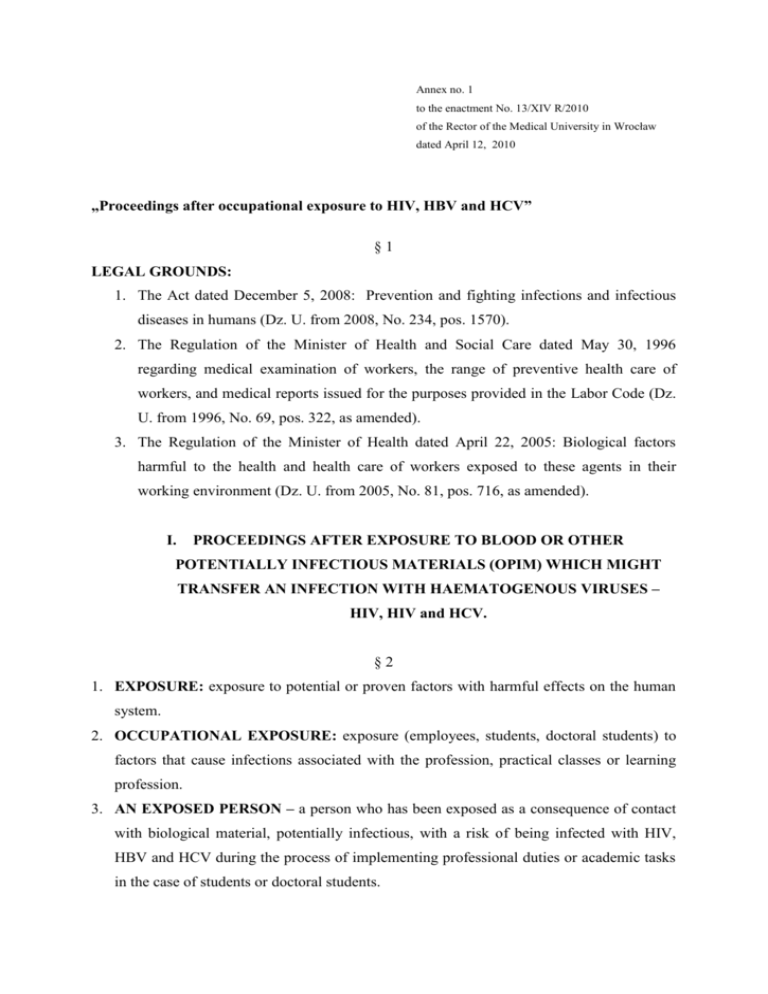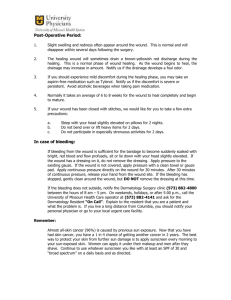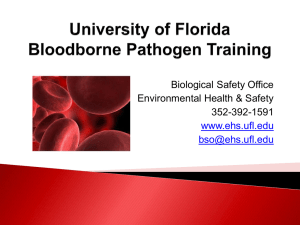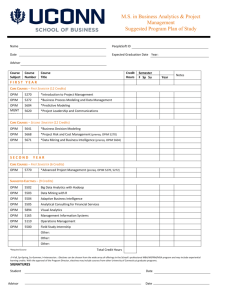Za**cznik nr 1
advertisement

Annex no. 1 to the enactment No. 13/XIV R/2010 of the Rector of the Medical University in Wrocław dated April 12, 2010 „Proceedings after occupational exposure to HIV, HBV and HCV” §1 LEGAL GROUNDS: 1. The Act dated December 5, 2008: Prevention and fighting infections and infectious diseases in humans (Dz. U. from 2008, No. 234, pos. 1570). 2. The Regulation of the Minister of Health and Social Care dated May 30, 1996 regarding medical examination of workers, the range of preventive health care of workers, and medical reports issued for the purposes provided in the Labor Code (Dz. U. from 1996, No. 69, pos. 322, as amended). 3. The Regulation of the Minister of Health dated April 22, 2005: Biological factors harmful to the health and health care of workers exposed to these agents in their working environment (Dz. U. from 2005, No. 81, pos. 716, as amended). I. PROCEEDINGS AFTER EXPOSURE TO BLOOD OR OTHER POTENTIALLY INFECTIOUS MATERIALS (OPIM) WHICH MIGHT TRANSFER AN INFECTION WITH HAEMATOGENOUS VIRUSES – HIV, HIV and HCV. §2 1. EXPOSURE: exposure to potential or proven factors with harmful effects on the human system. 2. OCCUPATIONAL EXPOSURE: exposure (employees, students, doctoral students) to factors that cause infections associated with the profession, practical classes or learning profession. 3. AN EXPOSED PERSON – a person who has been exposed as a consequence of contact with biological material, potentially infectious, with a risk of being infected with HIV, HBV and HCV during the process of implementing professional duties or academic tasks in the case of students or doctoral students. 4. Potential sources of HIV, HBV and HCV infection is every biological material which can include an amount of virus sufficient to infect: blood, cerebrospinal fluid, pleural fluid, pericardial, peritoneal and amniotic fluid, semen, vaginal secretions. 5. The most dangerous source of infection with the above mentioned viruses is blood. §3 Contact with above mentioned biological materials can be made by: a) Tearing the skin: needle-stick/prick, scratches or a wound with a tool contaminated with infectious material, b) Previously damaged skin – unprotected open wound, cut, crack, scratch or excoriation, c) Splashing of mucous membranes - mouth, eye conjunctiva, d) Prolonged exposure to intact skin with a significant amount of infectious material. §4 Exposure which does not require special treatment includes: 1) Exposure of intact skin 2) Questionable exposure: a) superficial wound with a needle considered uncontaminated with blood or OPIM, b) superficial wound with no visible bleeding caused by tools considered uncontaminated with blood or OPIM, c) pre-existing injury or wound contaminated with body fluid other than blood or OPIM, which does not contain traces of blood. §5 Exposure which requires post-exposure proceedings and post-exposure observation includes: 1) Probable exposure: a) intradermal wound by a needle contaminated with blood or OPIM, b) superficial wound with no visible bleeding caused by a tool contaminated with blood or OPIM, c) pre-existing injury contaminated with blood or OPIM, d) contact of mucous membranes or conjunctiva with blood or OPIM. 2) Clear exposure a) damage penetrating the skin with a needle contaminated with blood or OPIM, b) injecting blood, c) injury or similar wound with bleeding caused by a tool with visible contamination with blood or OPIM, d) every direct introduction of biological material (laboratory). 3) Massive exposure: a) blood transfusion, b) injection of a large amount of blood or OPIM (more than 1 ml), c) parenteral exposure to laboratory samples containing high titers of virus. II . PROCEEDINGS AFTER EXPOSURE TO MATERIAL POTENTIALLY INFECTIOUS WITH HAEMATOGENOUS VIRUSES – NONSPECIFIC PROCEEDINGS §6 1. Follow these steps immediately after exposure : 1) If there was a piercing or cutting of the skin, the sharp object should be immediately removed from the wound, 2) Abundantly rinse the wound with warm water, 3) Wash the area of the wound with warm water and soap, without stemming blood, as well as without squeezing blood (pressure on the wound facilitates aspiration of material into the wound), 4) Disinfect the wound with 3% hydrogen peroxide or an alcohol-based disinfectant, 5) Apply waterproof dressing, 6) If there is blood on the skin, regardless of the fact whether the skin was pre-injured or there are changes on it, such as abrasions, the skin should be thoroughly washed with water and soap, 7) If the eyes are contaminated, the area of the eyes should be mildly but thoroughly rinsed with injection water or 0.9% NaCl with eyelids open, 8) If blood gets into the mouth, the mouth should be rinsed with water several times (alcohol-based disinfectants should not be used for this). 2. Further proceedings: a) A person exposed should immediately report the incident to their immediate supervisor, for example, the plant manager, the doctor on duty, an academic teacher (depending on where the exposure took place); b) The duty of a person who accepted the declaration of exposure is: To conduct an interview and fill out the required documentation, To take a blood sample for virological examination of the exposed patient (with their consent), To direct the person exposed to undertake mandatory testing at the Wojewódzki Szpital Specjalistyczny (Regional Specialist Hospital) im. J. Gromkowskiego, 5 Koszarowa Street, tel. 71 326 13 25, the person exposed should as soon as possible – the best would be within 1-2 hours after the exposure (not later than 24 hours) - go to the Wojewódzki Szpital Specjalistyczny im. J. Gromkowskiego (specialist ambulatory care or infectious admission chamber), 5 Koszarowa Street, tel. 071 326 13 25. A referral is necessary, however if obtaining such a referral would cause any delays in going to the hospital, the person exposed should go to the hospital without the above mentioned referral; the referral should then be delivered within the next 7 days. The person exposed should – if possible – take a blood sample of the patient who is the source of the exposure (9cm for a clot), A doctor specializing in infectious diseases is required to provide medical advice; blood serology is recommended, and when necessary a diagnostic procedure is implemented and a prescription for antiretroviral drugs is prescribed; c) The person exposed can realize the prescription for the above mentioned drugs for free in the Calamus pharmacy, 168 Powstańców Śląskich Street, Tel: 71 337 18 72, with which the university has signed an agreement in this regard. The antiretroviral drugs recommended by the consulting specialist should be taken immediately after the patient collects them. d) Purchased drugs are being administered in the hospital during the re-appointed specialist consultation. 3. Regarding people who conduct professional or practical training in a factory/institution located outside of Wrocław: 1) The person exposed who conducts practical training outside of the university headquarters, is submitted to a procedure which is in force in the factory/institution in which they conduct their practical training or practical activities. 2) Should it be necessary to conduct specialist examinations or realize a prescription for antiretroviral drugs, the university covers the costs on the basis of a VAT invoice issued for the Medical University in Wrocław (Akademia Medyczna im. Piastów Śląskich we Wrocławiu, ul. L. Pasteura 1, 50-367 Wrocław, NIP 896-000-57-79) and delivered to the Division of Student Affairs. A description of the incident confirmed by the factory/institution where the exposure took place should be attached to the invoice. III. DUTIES AND RESPONSIBILITIES §7 1. A duty of each employee of the Medical University, of each student or doctoral student is to follow the proceedings and report the incident to the Health and Safety Inspectorate and Fire Protection Inspectorate, Wybrzeże L. Pasteura 2, 50-368 Wrocław, tel. 71 784 11 40, and in case of students also to the Division of Student Affairs, 12 Wojciecha z Brudzewa Street, tel. 71 348 42 32 extension number 12. 2. Confirmation that employees, students and doctoral students have become familiar with the proceedings regarding occupational exposure to HIV, HBV and HCV viruses is included in Annex no. 1 to these proceedings after exposure. 3. Documentation which constitutes the basis to settle the service charges resulting from the proceedings should be confirmed by the Division of Student Affairs. §8 The matters related to the reimbursement for the procedure after occupational exposure of a person exposed – a student or a doctoral student – are settled by the Division of Student Affairs, to which the invoice for the examinations and antiretroviral drugs should be provided.









